Did you know that there are over 180,000 different caterpillar species in the world? These squirmy animals are among the most diverse in the world. You can find many different caterpillar species in Alabama. In this Southern state, you’ll encounter various fascinating larval creatures, each on their unique journey to becoming vibrant butterflies or moths. Interestingly, among this crowd, some are more than just visually captivating – they are also poisonous or venomous!
This article will help you identify these caterpillars, understand their unique behaviors, and learn about the threats they can pose. Let’s step into the world of Alabama’s caterpillars, highlighting the ones that require your cautious attention.
1. American Dagger Caterpillar (Acronicta americana)
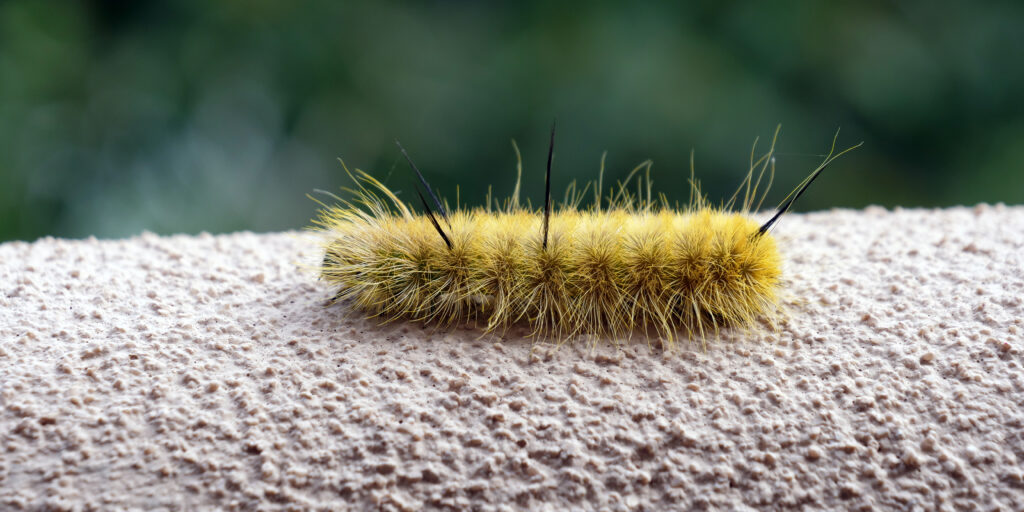
An extremely toxic
caterpillar
in Alabama is the American dagger caterpillar. The sting of this caterpillar causes a stinging sensation.
©Martha Marks/Shutterstock.com
The American dagger caterpillar possesses a unique fuzzy exterior, with colors ranging from pale yellow to soft green and even white. This small creature also has four sleek, dark bristles known as ‘setae’ that protrude from the first and third segments of its abdomen. Additionally, a fifth black bristle prominently stands out near its rear end.
These caterpillars sustain themselves by feeding on the leaves of various hardwood trees, including ash, elm, and oak. Such feeding grounds are commonly found in parks, forests, and wooded areas throughout the growing period.
Despite their appealing appearance, it’s vital to know that these caterpillars carry toxins. It is strongly advised not to touch them! That said, these caterpillars only carry toxins during the caterpillar stage of their lifecycle. When the caterpillar transforms into a moth, they are no longer dangerous.
2. Buck Moth Caterpillar (Hemileuca maia)

These caterpillars consume the leaves of various trees in Alabama and are a common site in spring and summer.
©iStock.com/Oleg Marchak
The buck moth caterpillar, when fully grown, measures about two inches in length and showcases a color spectrum from brown to deep purple-black. Its body is spotted with yellow markings and adorned with forked black spines, which may be tipped in either red or black. These caterpillars are a familiar sight on oak and willow trees in Alabama, particularly from spring through mid-summer.
Their diet consists primarily of leaves from various oak trees, including the blackjack oak, live oak, scrub oak, and dwarf chestnut oak.
Be aware! The seemingly delicate spines on these caterpillars are actually toxic. They are hollow and linked to poison glands beneath the skin. Touching them can result in a burning, inflamed reaction comparable to the pain experienced by a bee sting. Just as with the American dagger moth, though, adult buck moths are not toxic.
3. Eastern Black Swallowtail Caterpillar (Papilio polyxenes)

This caterpillar is the state
butterfly
of Oklahoma, but they are also a common caterpillar species in Alabama.
©Karel Bock/Shutterstock.com
The eastern black swallowtail caterpillar stands out in the crowd with its vibrant green body and rows of black and yellow dots stretching from one end to the other. This caterpillar has a noticeably larger head and thorax in comparison to its back, and its legs, including the auxiliary ones known as ‘pro-legs’.
This species has a particular fondness for parsley plants. If you’re in Alabama and choose to grow a bit of extra parsley, you’re likely to enjoy the sight of the stunning eastern black swallowtail butterfly after just a few weeks. However, these caterpillars can quickly become a problem for your crops if they arrive in larger numbers!
4. Io Moth Caterpillar (Automeris io)
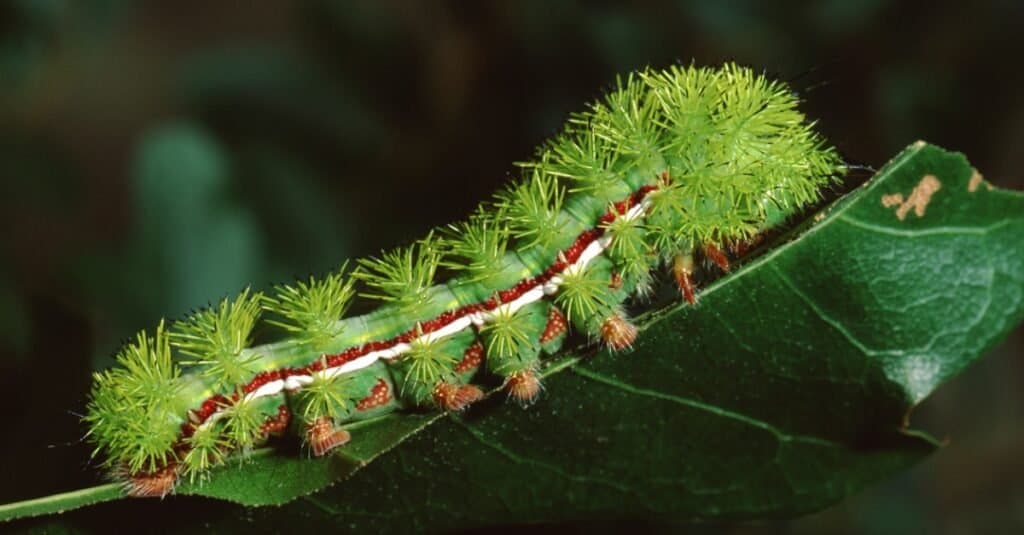
This extremely large and unique-looking caterpillar is venomous and can administer a highly painful sting.
©iStock.com/Weber
The io caterpillar is colored in a shade of green and boasts two distinctive stripes on each side – one crimson and the other white. Its body is covered with tiny green spikes, with lighter patches of green peeking out in between.
These caterpillars predominantly make their homes in hackberry and willow trees.
In the world of stinging caterpillars, io moth caterpillars are notorious, ranking high on the list of most harmful species. The spikes that embellish the caterpillar’s body are connected to venom glands. A sting from an Io caterpillar can be excruciating and cause irritation and swelling. Avoid touching this species at all costs.
5. Large Tolype Caterpillar (Tolype velleda)
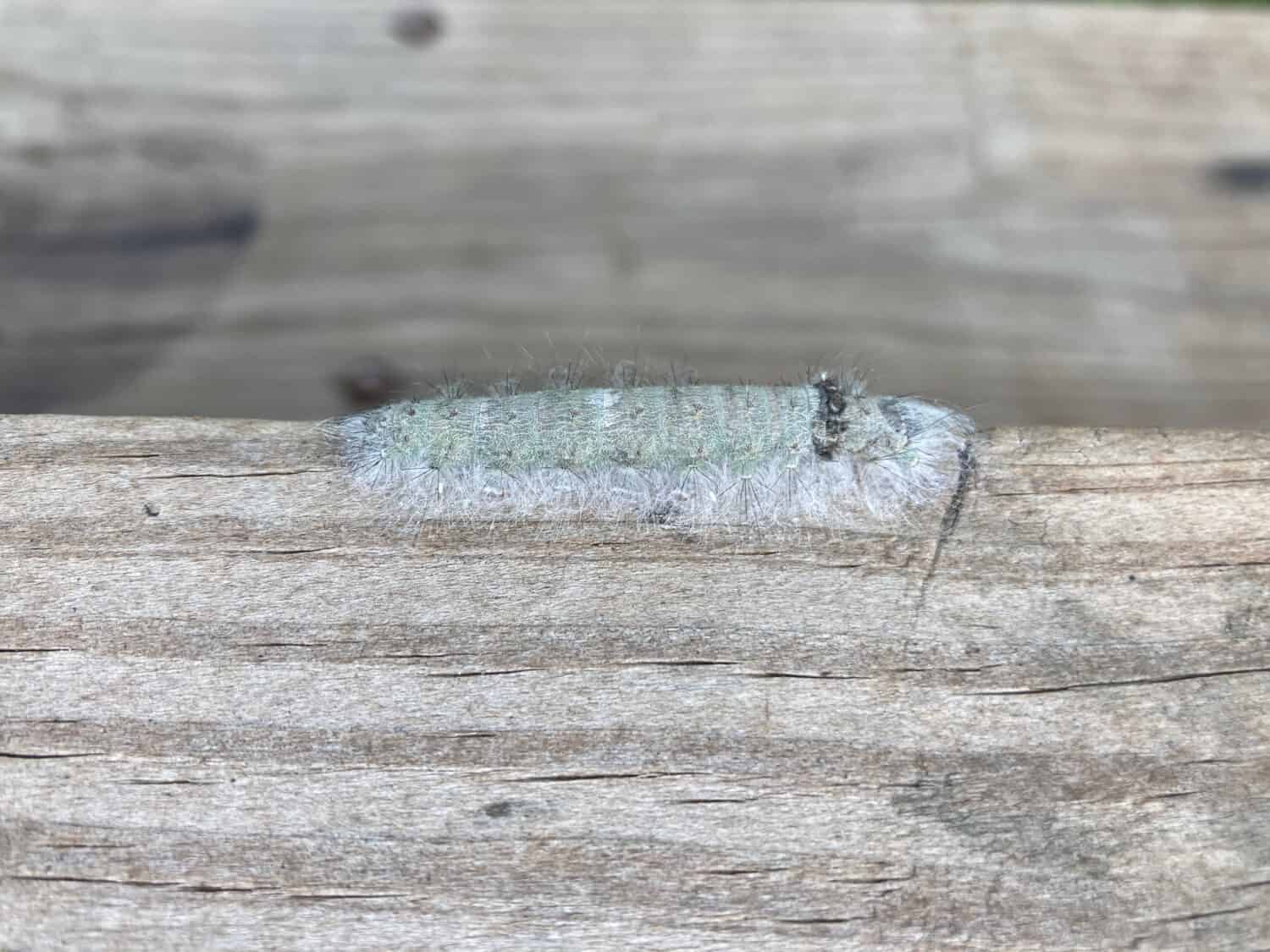
The tolype caterpillar and moth are both poisonous.
©B. Kelly Swanson/Shutterstock.com
The large tolype caterpillar sports a drab gray color and is exceptionally furry. Notably, it has a flap on its pro legs, a feature that fades away as it matures. You’ll typically find these caterpillars active in the summer between June and August.
They primarily feed on the foliage of broadleaf trees and shrubs, such as ash, aspen, apple, and basswood.
Tolype moths are not the most common caterpillar in Alabama, but they can still be found in the state. These caterpillars and the adult moths are poisonous. They are a variant of the tussock moth, and their caterpillars are enveloped in pointed spines. These can cause significant skin irritation if humans come into contact with them.
6. Monkey Slug Caterpillar (Phobetron hipparchia)
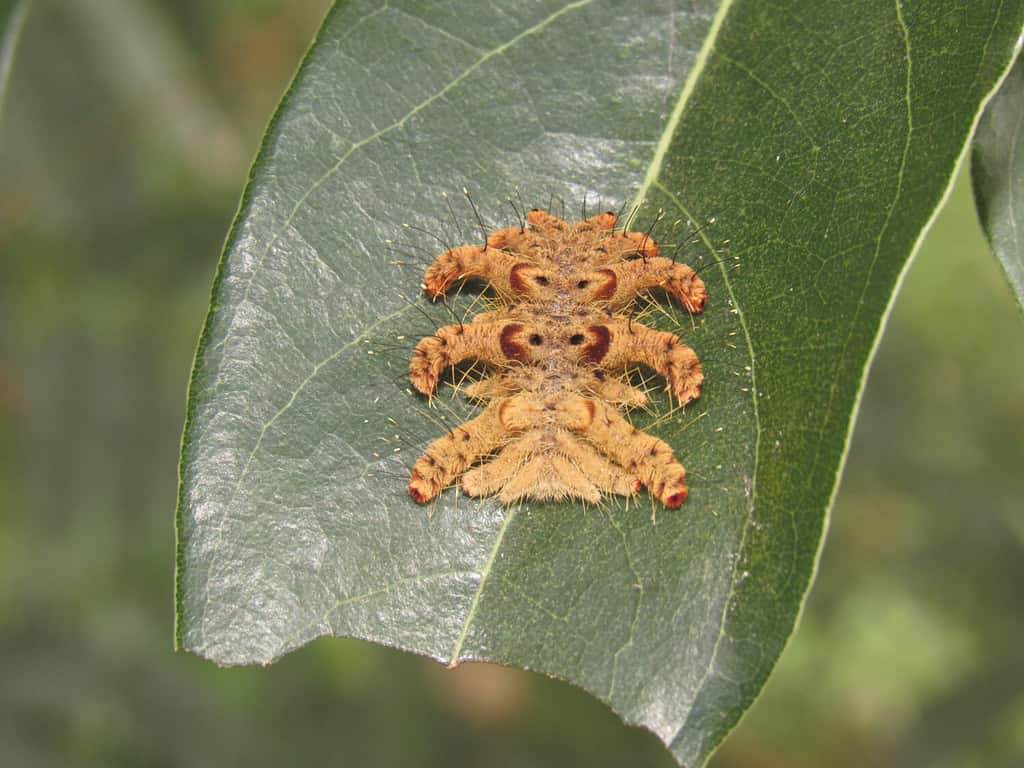
Undoubtedly one of the strangest-looking caterpillar species in Alabama is the monkey slug.
©Fabio Ara/Shutterstock.com
Resembling a fuzzy, brown, and slightly elongated version of a starfish, the monkey slug caterpillar, which eventually transforms into the hag moth, possesses a peculiar appearance. These caterpillars, often associated with oak slug moths, come equipped with stinging hairs. Instead of the usual pro legs, they sport suckers, enabling them to slide around much like slugs.
These caterpillars enjoy a diverse diet, feeding on various trees and shrubs. This includes fruit trees, roses, dogwood, and oak trees.
While their bizarre appearance might make them seem like creatures to steer clear of, the monkey slug caterpillar is generally harmless and should not be feared.
7. Pipevine Swallowtail Caterpillar (Battus philenor)

This caterpillar, while a sight to behold, is poisonous and can be a huge problem if ingested.
©Sundry Photography/Shutterstock.com
The pipevine swallowtail caterpillars have primarily black bodies with red outgrowths and spots trailing along their spines. This distinctive appearance renders them less appealing to potential predators.
Known alternatively as blue swallowtails, these caterpillars have a specific palate, preferring the leaves of birthworts and Dutchman’s pipes, botanically recognized as Aristolochia.
However, it’s crucial to remember that the pipevine swallowtail caterpillars are highly toxic. If ingested by either a child or an adult, they could potentially lead to serious health complications.
8. Eastern Tiger Swallowtail Caterpillar (Papilio glaucus)
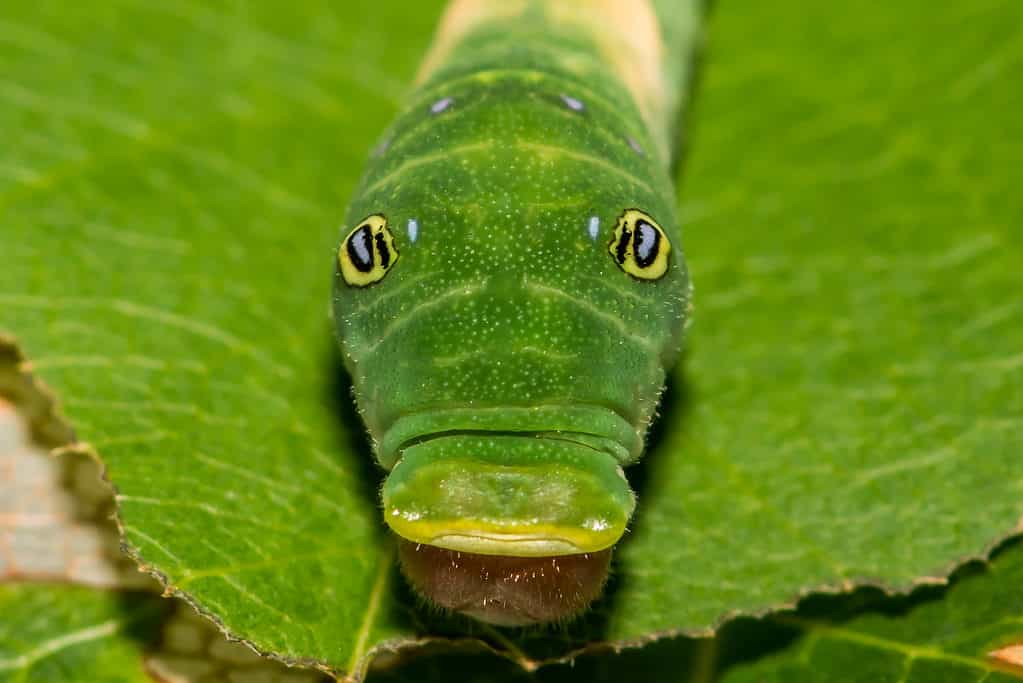
This caterpillar disguises itself as a snake to avoid predation and stay hidden.
©Jay Ondreicka/Shutterstock.com
Eastern tiger swallowtail caterpillars have a fascinating life cycle. As tiny creatures, they have a green coloration with two large eyespots on top. This clever adaptation tricks predators into thinking the caterpillar is a snake and gives them camouflage! As they grow older, these caterpillars transform into a vibrant green hue, showcasing stunning eyespots in black, yellow, and blue on their upper body, which is, surprisingly, not their real eyes!
These larvae have quite a diverse diet, feasting on the leaves of several types of trees, such as wild cherry, tulip, birch, and ash.
Despite their striking appearance, these caterpillars are harmless and don’t carry any poison.
9. Question Mark Caterpillar (Polygonia interrogations)
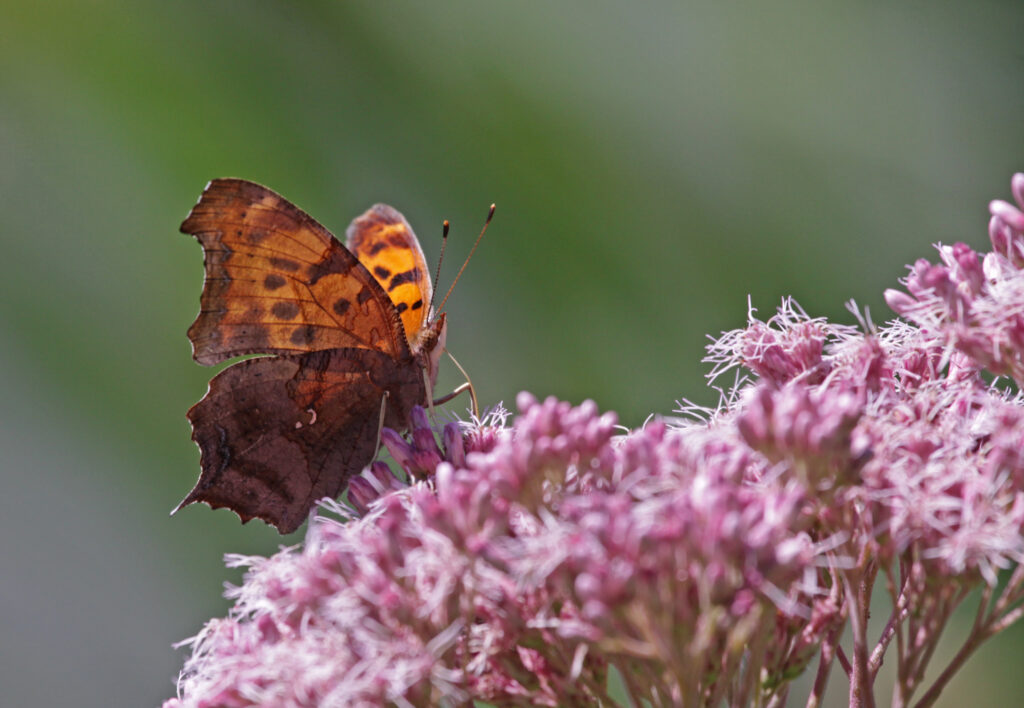
This gorgeous butterfly is what the question mark caterpillar grows up to be.
©Chris Hill/Shutterstock.com
The caterpillars of the question mark butterfly stretch out to about 1.5 inches in length. They possess a reddish-brown head adorned with short spikes. These dark caterpillars stand out with their irregular, light-hued lines and speckles. Spiny outgrowths mark each segment of their bodies, lending them a notably prickly look.
Their preferred diet consists of leaves from various plants, such as the American elm, false nettle, and hackberry, among others.
The caterpillar’s body is enveloped in spines, presenting a blend of yellow, orange, and black hues, which serve as a defensive mechanism against predators. However, these spines are not poisonous.
10. Red Admiral Caterpillar (Vanessa atalanta)
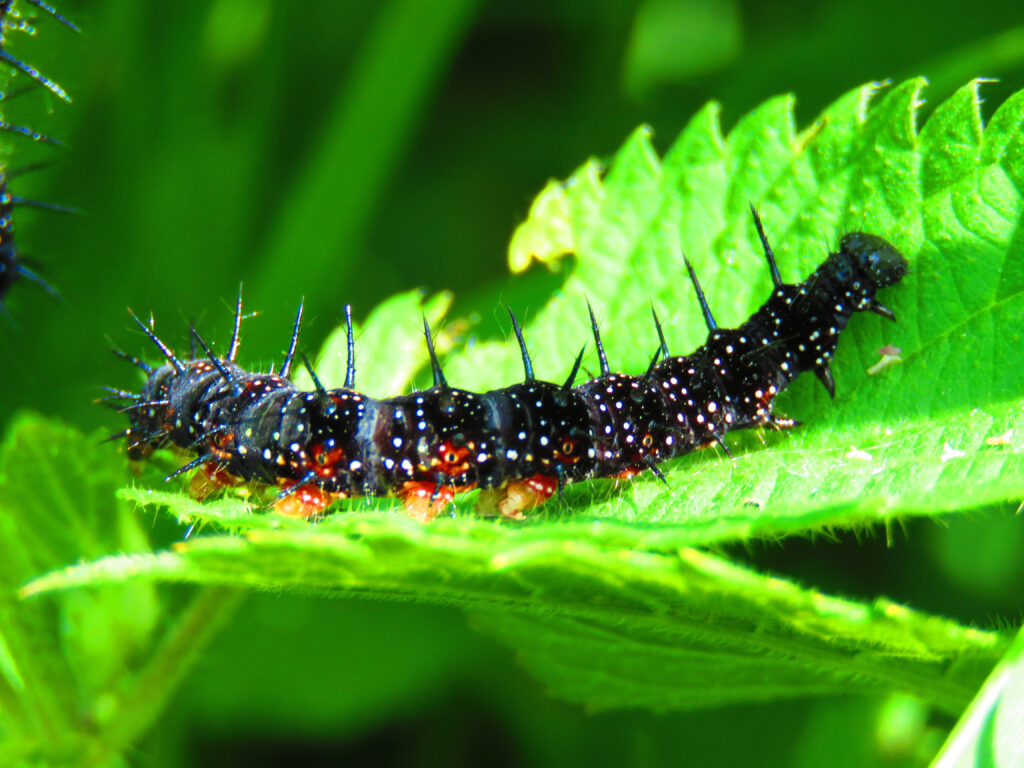
The red admiral caterpillar is a beautiful and spiky caterpillar in Alabama.
©Przemyslaw Muszynski/Shutterstock.com
The appearance of red admiral caterpillars undergoes significant transformations with each successive larval growth stage. Their color palette can range from black to greenish, whitish, or brown, featuring a multitude of small warts and dark spikes. These caterpillars hibernate during the adult or pupal stage, but they don’t survive in extremely cold temperatures.
These caterpillars primarily feed on stinging nettles.
Despite their menacing appearance that may lead you to think these animals are harmful or toxic, red admiral caterpillars are actually safe to handle and pose no danger.
11. Redhumped Caterpillar (Schizura concinna)
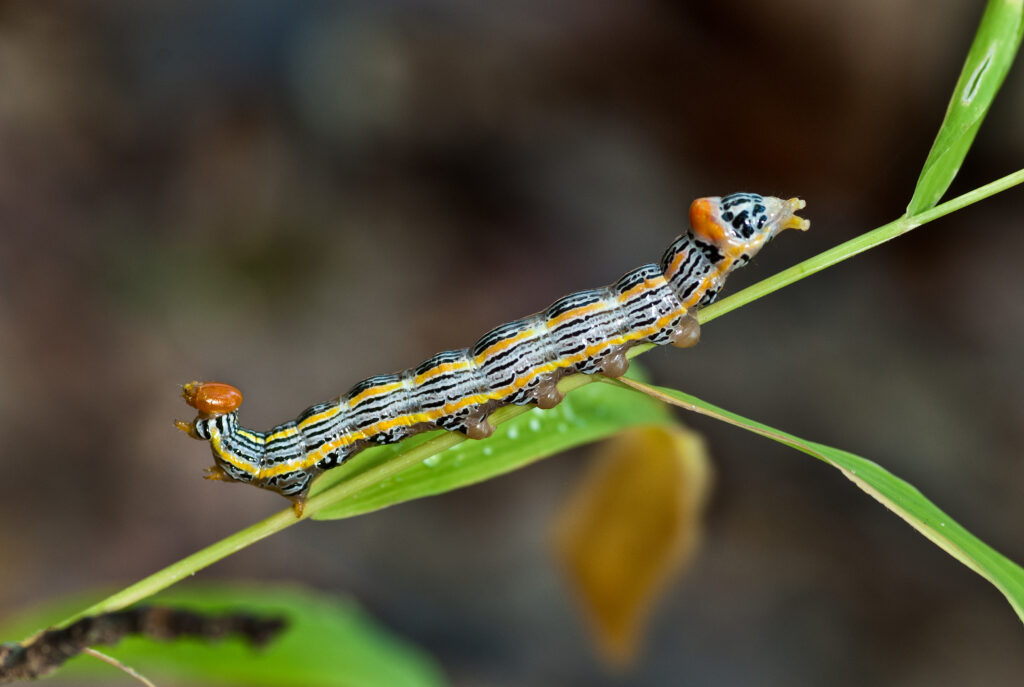
This caterpillar is divided into several different humps that give it its name.
©Gerry Bishop/Shutterstock.com
The redhumped caterpillar stands out due to its unique visual attributes: a yellow body streaked with longitudinal stripes in shades of red and white. The head is a vivid red, and the fourth abdominal segment is both red and noticeably enlarged.
These caterpillars are often found munching on the leaves of sweet gum (liquidambar), plum, and walnut trees. When they appear in large quantities, these caterpillars are capable of drastically stripping trees of their foliage.
Despite their unique appearance, redhumped caterpillars are not toxic and present no harm to humans.
12. Saddleback Caterpillar (Acharia stimulea)
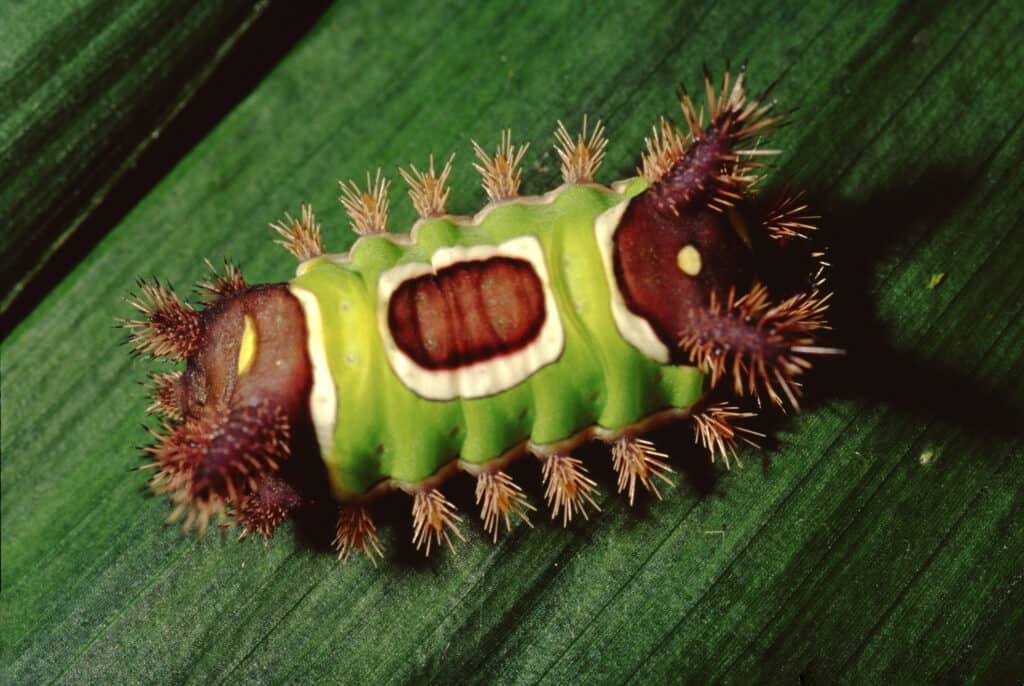
You can easily see where the “saddle” part of the saddleback caterpillar’s name comes from.
©Liz Weber/Shutterstock.com
Saddleback caterpillars are easily identifiable by their green backs, which are adorned with a centrally located brown dot enclosed by a white ring. Their brown ends, textured skin, and pairs of horns add to their unique appearance. Measuring an inch long, their bodies have a slug-like shape during the larvae stage.
These caterpillars consume the leaves of a wide variety of plants, including dogwoods, gladiolas, and crape myrtle, among several others.
They are venomous, and their sting can be particularly dangerous for some people, possibly necessitating medical attention.
13. Spicebush Swallowtail Caterpillar (Papilio troilus)
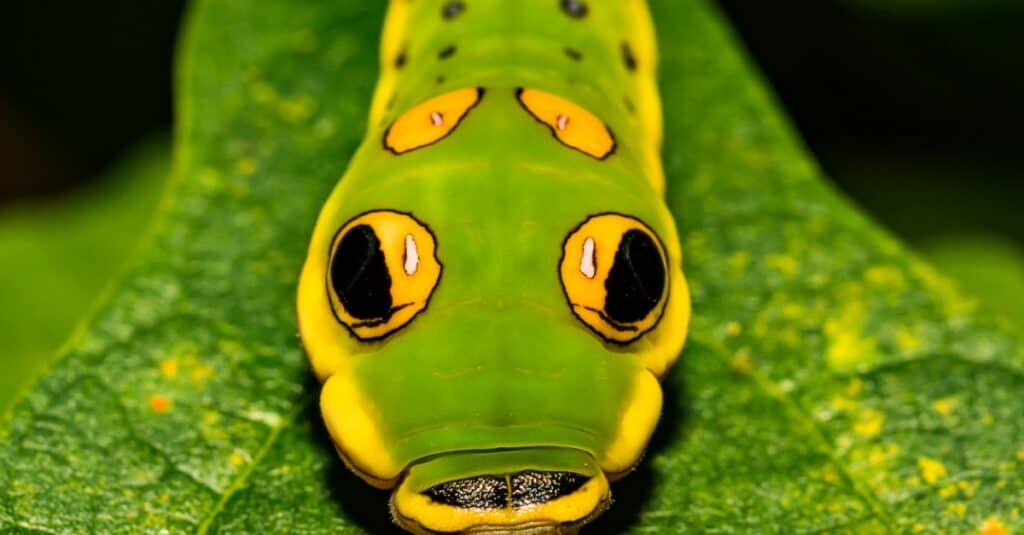
Another caterpillar that disguises itself as a snake to avoid predation is the spicebush caterpillar.
©iStock.com/JasonOndreicka
Upon hatching, the spicebush caterpillar is diminutive in size, dark brown, or black with a distinctive white spot or streak. This unique coloring makes them resemble bird droppings.
These caterpillars usually feed on plants like sweet bay, spicebush, sassafras, and tulip trees. They have a habit of folding the leaf edges over, crafting a silk-lined refuge where they withdraw when not feeding.
Even though they exhibit a pair of intimidating eyespots, spicebush swallowtail caterpillars are completely harmless.
14. Stinging Rose Caterpillar (Parasa indetermina)
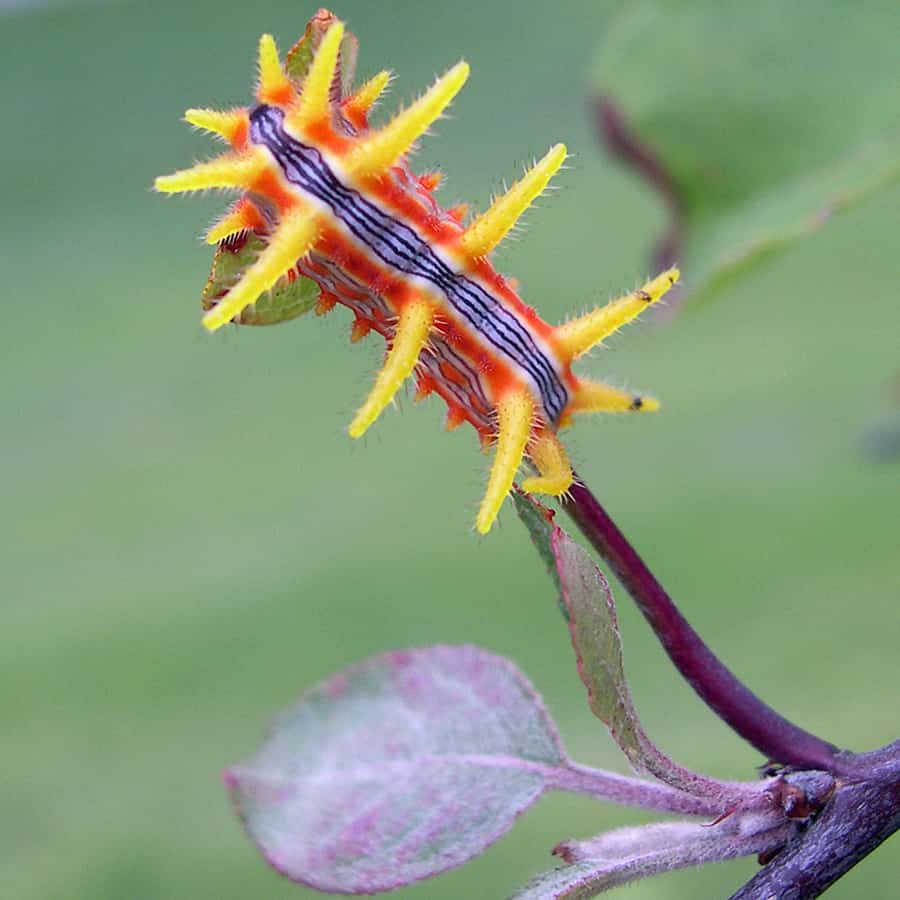
This insane-looking caterpillar looks extraterrestrial. But despite its otherworldly appearance, avoid touching it! It is venomous.
©M. Whitson / CC BY 4.0 – License
The stinging rose caterpillar is recognized by its seven pairs of horn-like spines, along with smaller spiky bumps lining its sides. Each spine is hollow and filled with a nettling liquid. If the spine comes into contact with human skin, the tip breaks off, discharging the irritating liquid, leading to a painful sting.
These caterpillars enjoy a diet that includes apple, cherry, dogwood, maple, paw paw, plum, and rose leaves. Despite their extensive host range, this species is somewhat uncommon in Alabama.
It’s best to avoid these caterpillars, as their sting contains a painful and irritating venom.
15. Monarch Caterpillar (Danaus plexippus)
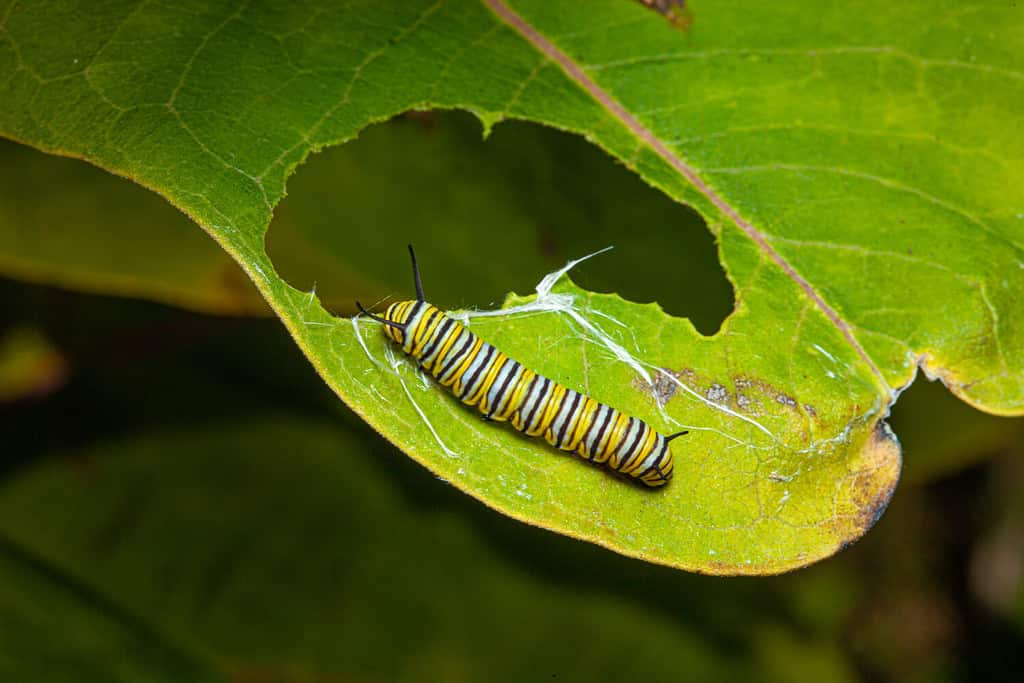
These caterpillars almost exclusively feed on milkweed plants.
©K Hanley CHDPhoto/Shutterstock.com
Monarch caterpillars are one of the most iconic caterpillars found in Alabama. These larvae sport black, white, and yellow stripes and can reach a size of two inches before undergoing their transformative stage. They are adorned with two pairs of antenna-like tentacles, one pair at each end of their body.
Their survival and transformation into butterflies are dependent on milkweed plants, their exclusive food source.
While the Monarch Butterflies may seem harmless, they are actually poisonous due to the absorption of chemicals known as glycosides, specifically cardenolides, from the milkweed.
16. Woolly Bear Caterpillar (Pyrrharctia Isabella)
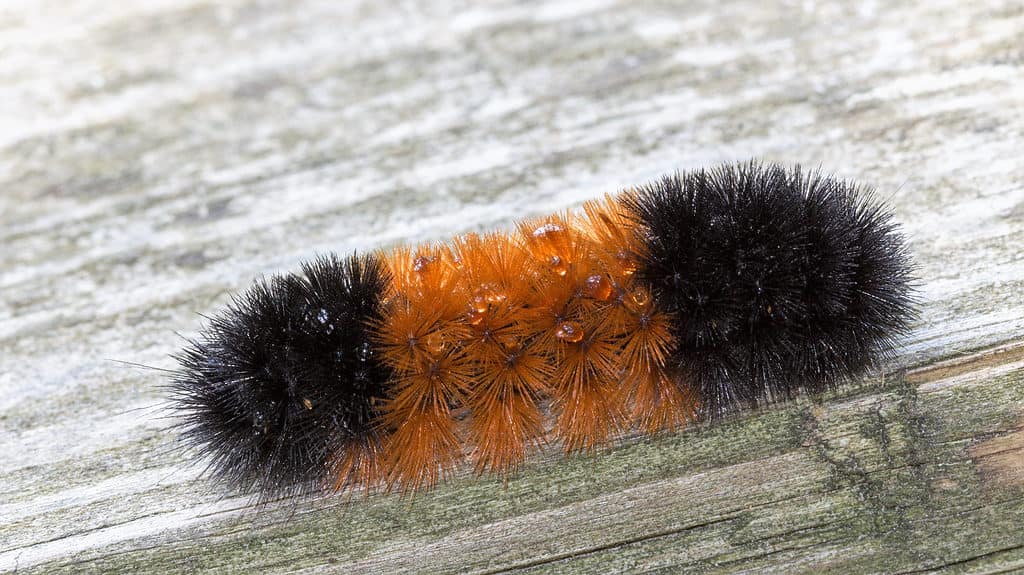
This fuzzy caterpillar is not harmful at all and does not possess any toxins.
©Kimberly Boyles/Shutterstock.com
Perhaps one of the most famous fuzzy caterpillars in Alabama is the woolly bear. In terms of their physical characteristics, these caterpillars exhibit 13 distinct segments, colored either a rusty brown or black. Often, they are black at both ends, with the central segments being rust-colored, although their coloration can sometimes lean towards being predominantly black or predominantly rust.
Fun fact: Caterpillars that are entirely black, white, or yellow aren’t classified as woolly bears!
The diet of woolly bear caterpillars primarily consists of low-growing, wild, and herbaceous plants such as dandelion, dock, and aster.
Fear not, as woolly bears pose no danger to humans and can be handled without any worry of toxicity.
17. Cabbageworm Caterpillar (Pieris rapae)
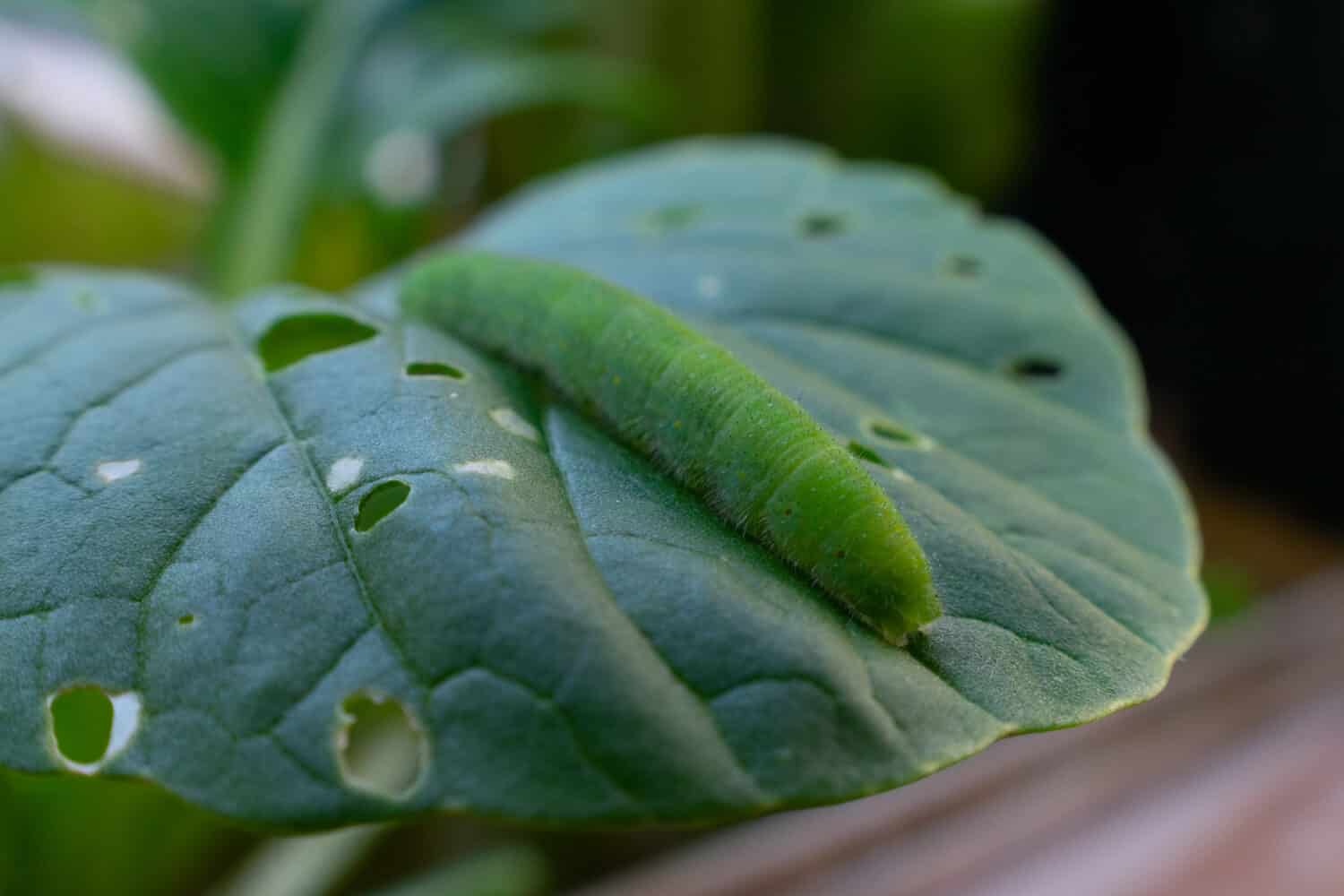
This green caterpillar disguises itself on the leaves it consumes.
©Kelsey Armstrong Creative/Shutterstock.com
Cabbageworm caterpillars are characterized by their green color and a multitude of tiny hairs that lend a velvety texture to their skin. As they age, they can grow up to an inch long, often displaying a subtle yellow-orange line running down their back and disjointed lines along their sides. Notably, these caterpillars are known for their slow movement compared to their peers.
Their diet is mostly based on plants from the Cruciferae family, but they occasionally feed on other plant families that are rich in mustard oils.
While these caterpillars may threaten your plant life, rest assured that they are not poisonous and do no harm to humans.
18. Giant Leopard Caterpillar (Hypercompe scribonia)

In its larval stage, the giant leopard moth can grow to a length of about two inches, boasting a body covered in glossy black bristles. Unlike certain other ‘hairy’ species, the bristles on these caterpillars aren’t urticating, implying they don’t detach and cause irritation or discomfort when they come into contact with predators.
These caterpillars have a wide-ranging diet, feeding on an array of leafy vegetation, including dandelions, violets, and honeysuckle.
Notably, giant leopard moth caterpillars are harmless and don’t carry any poison.
19. Cecropia Moth Caterpillar (Hyalophora cecropia)

This caterpillar’s body is full of bristles, but they are not venomous or poisonous.
©K Hanley CHDPhoto/Shutterstock.com
The cecropia caterpillar is quite large, with fifth-stage larvae growing up to 4.5 inches long. The body displays a vibrant green or aquamarine hue, adorned with distinctive dorsal bumps, each bearing black spines at their tips. The bumps on their thorax are orange or red, the abdominal bumps are yellow, and those on the side are a soft blue color.
Their diet primarily consists of leaves from a variety of trees and shrubs, such as ash, birch, box elder, and alder.
While it might look rather unusual, enough to deter some predators, this caterpillar is not poisonous and is safe to touch.
20. Southern Flannel Caterpillar (Megalopyge opercularis)
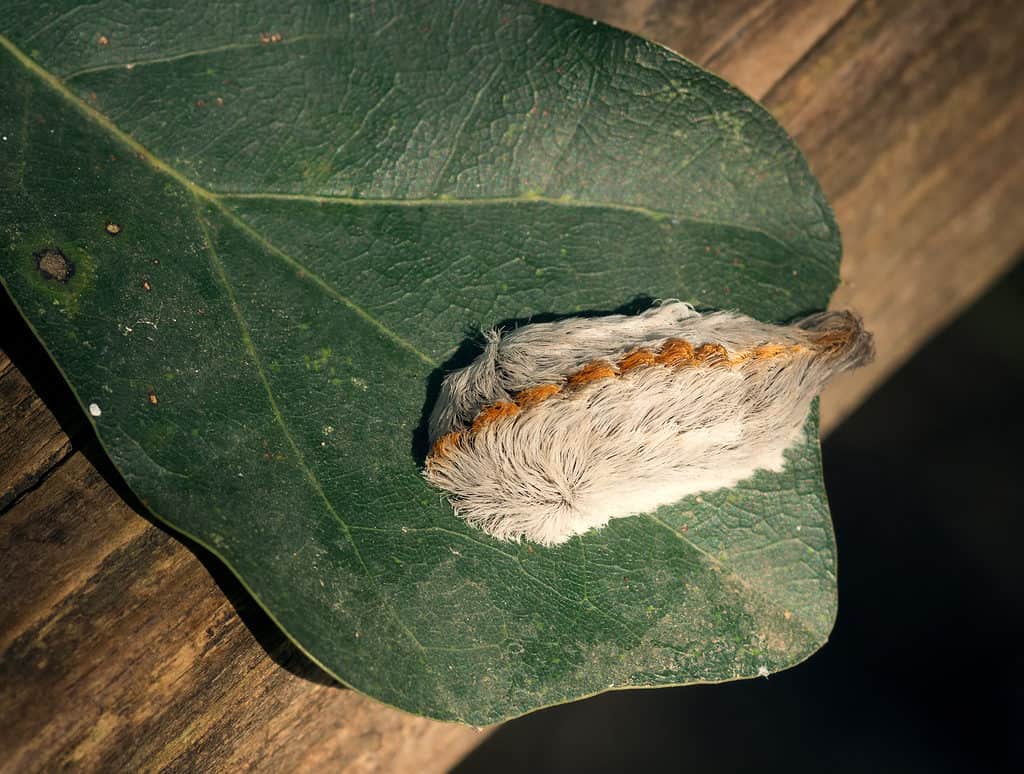
This caterpillar in Alabama looks like a giant ball of hair!
©IrinaK/Shutterstock.com
The southern flannel caterpillar possesses an intriguing range of colors, much like cats. They can range from a muted white-gray to a golden light brown with vivid orange streaks or even a smoky gray hue. When it’s still in its early development stages, the caterpillar’s ‘coat’ can be remarkably curly, giving it an even fluffier appearance.
Their diet is quite diverse, munching on leaves from an array of plants, including but not limited to oak and elm trees.
Despite its harmless appearance, if you accidentally touch a southern flannel caterpillar, you’ll feel the prick of its poisonous spines. Quick removal of these stingers is essential, followed by seeking immediate medical attention. If not addressed promptly, the potent venom can send your body into a state of shock.
Regions in Alabama with the Most Caterpillars
Alabama boasts plenty of ecosystems that caterpillars call home. The top spots with the most caterpillars are as follows.
- Mobile-Tensaw River Delta: Known as “America’s Amazon,” this region’s rich wetlands provide an ideal environment for a diverse range of caterpillar species due to its dense vegetation and high biodiversity.
- Appalachian Mountains: The Alabama stretch of this mountain range is teeming with deciduous forests. The variety of tree species present serves as abundant food sources, supporting many caterpillar species.
- City Parks: Urban green spaces across Alabama cities, like Birmingham’s Ruffner Mountain and Montgomery’s Blount Cultural Park, are mini-ecosystems providing suitable habitats for a variety of caterpillars.
- Talladega National Forest: This expansive forest offers an exceptional environment for caterpillars, with its array of native plants serving as food. Its high biodiversity makes it a hotspot for caterpillars.
In these regions, the lush vegetation and protected habitats offer caterpillars the nourishment and safety they need to flourish.
Summary of Caterpillars Found in Alabama
| Number | Caterpillar | Type of Caterpillar | Poisonous? |
|---|---|---|---|
| 1 | American Dagger Caterpillar | Moth | Yes |
| 2 | Buck Moth Caterpillar | Moth | Yes |
| 3 | Eastern Black Swallowtail Caterpillar | Butterfly | No |
| 4 | Io Moth Caterpillar | Moth | Yes |
| 5 | Large Tolype Caterpillar | Moth | Yes |
| 6 | Monkey Slug Caterpillar | Moth | No |
| 7 | Pipevine Swallowtail Caterpillar | Butterfly | Yes |
| 8 | Eastern Tiger Swallowtail Caterpillar | Butterfly | No |
| 9 | Question Mark Caterpillar | Butterfly | No |
| 10 | Red Admiral Caterpillar | Butterfly | No |
| 11 | Redhumped Caterpillar | Moth | No |
| 12 | Saddleback Caterpillar | Moth | Yes |
| 13 | Spicebush Swallowtail Caterpillar | Butterfly | No |
| 14 | Stinging Rose | Moth | Yes |
| 15 | Monarch Caterpillar | Butterfly | Yes |
| 16 | Woolly Bear Caterpillar | Moth | No |
| 17 | Cabbageworm Caterpillar | Butterfly | No |
| 18 | Giant Leopard Moth Caterpillar | Moth | No |
| 19 | Cecropia Moth Caterpillar | Moth | No |
| 20 | Southern Flannel Caterpillar | Moth | Yes |
The photo featured at the top of this post is © Kelsey Armstrong Creative/Shutterstock.com
Thank you for reading! Have some feedback for us? Contact the AZ Animals editorial team.






